Hammer Toes/Claw Toes/Crooked Toes Treatment Perth
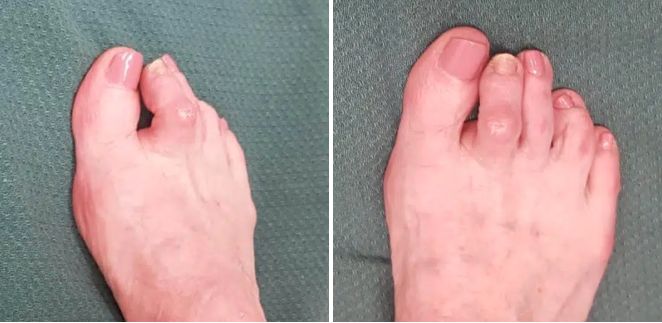
Relieve Pain & Correct Deformity with Expert Podiatry Care
Are you struggling with curled, painful toes that make walking uncomfortable? At Foot Focus Podiatry Perth, we provide comprehensive and effective Hammer Toe treatment in Perth designed to ease pain, improve mobility, and prevent the condition from worsening.
Our experienced Perth podiatrists understand the discomfort and self-consciousness that hammer toes can cause. We are here to help you find lasting relief with tailored treatment plans — without jumping straight to surgery.
Quick Scroll Options:
Hammer Toe Non-Surgical Treatment Options
Why choose non surgical treatment options? At Foot Focus Podiatry, we take a comprehensive approach to treating hammer toes, and our treatment options are tailored to your specific condition. Early diagnosis and intervention can help prevent the condition from worsening and we aim to manage symptoms, restore function, and even prevent the need for surgery.
Our Non-Surgical Treatments Include:
- Custom Orthotic Inserts: Custom–made shoe inserts can provide better foot alignment, reduce pressure on the toes, and improve overall foot function.
- Footwear Advice: Wearing proper footwear is key to managing hammer toes. We offer advice on choosing shoes that provide proper support and comfort and fitting. Avoiding high heels is also recommended.
- Stretching and Strengthening Exercises: Stretching and strengthening the tendons and muscles around the toes can help improve flexibility and reduce pain.
- Padding and Cushioning: Special pads or cushions can be placed in shoes to relieve pressure on the affected toes and prevent rubbing. For example; toe props, metatarsal domes, silicone pads, and other cushioning devices are available to Foot Focus Podiatry.
- Foot Exercises: Stretching and strengthening exercises for the toes can improve flexibility and alleviate pain or discomfort.
- Pain Management: If necessary, we may recommend over-the-counter pain relief options or anti-inflammatory treatments to reduce swelling and pain.

Above is an example of some toes devices we offer here at Foot Focus Podiatry.
Why Choose Foot Focus Podiatry for Hammer Toes Treatment?
- 110 years of combined experience
- 7 podiatrists with up to 25 years of individual experience diagnosing and treating hammer toes.
- Podiatric surgeon with over 24 years of experience for complicated cases
- Our practice has been operating since 2000 in the same location
- Work together as a team and stay up to date with the latest treatment techniques to provide you with the best care possible.
- All of our podiatrists explore all conservative options before recommending surgical consultation.
- From conservative care to surgical options, we offer a full range of treatments to address hammer toes effectively.
- Our clinic supports you throughout your foot care journey—from conservative treatment through surgery and rehabilitation if needed
- Offers:
- Conservative treatment
- Surgical consultations - comprehensive pre- and post-surgical care
- In-house rehabilitation after surgery
- Dr. Reza Naraghi is a highly qualified podiatric surgeon with over 24 years of experience
- Has written research publications on hammertoes, bunions, warts and more. To learn more about Dr Reza, please read more
- Trained in the USA
- Currently serves as chairman of education for ACPS (Australasian College of Podiatric Surgeons)
- Understands the importance of exhausting all conservative measures before considering surgery
- Performs the latest surgical procedures based on up-to-date, evidence-based findings
- We offer rehabilitation after surgery (if required) to restore better mobility and strength
We understand that each patient is unique. Our team will work with you to develop a treatment plan that suits your individual needs.
Our clinic is designed to make you feel at ease from the moment you walk in. We pride ourselves on providing a friendly, welcoming atmosphere for all our patients.
Types of Crooked/Hammer Toes
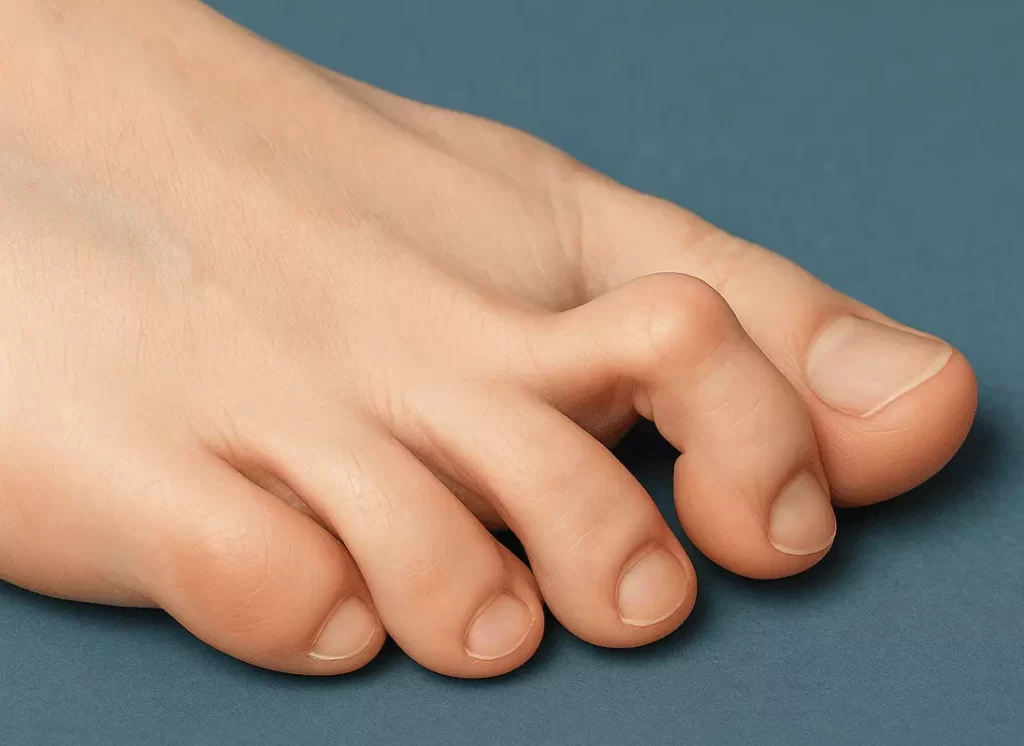
Figure One: Hammertoe. The intermediate joint (“proximal interphalangeal”) of a toe is flexed downward, and typically occurs on the 2nd, 3rd and 4th toe. Often this causes corns, pain and difficulty wearing closed footwear.

Figure Two: Mallet Toe. The joint that is closest to the tip of the toe (“distal interphalangeal joint”) is in fixed flexion or bending downward while the rest of the toe remains straight. This causes rubbing and pressure at the tip of the toe.
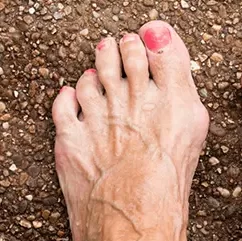
Figure Three: Claw Toe. When both of the joints, (the proximal and distal interphalangeal joints) are flexed downward, while the metatarsophalangeal joint is extended upward, typically affecting toes 2-5. Sometimes the claw toe is rigis or fixed, and can often be worsened by muscle imbalance.
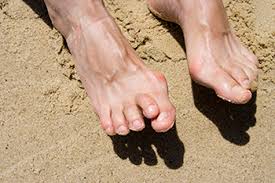
Figure Four: Overlapping Toe. When one toe overlaps and lies on top of another toe, it is called an overlapping toe. Sometimes present from birth, but otherwise these are caused by persistant pressure, tight footwear or an abnormality in the bone structure.
Figure Five: Adductorvarus Toe. When a toe is drawn inward and turned in a varus position (toward the plantar surface), it is called an ‘adductovarus’. This is often seen in the 5th toe and is typically caused by shoe pressure.
Curly Toe. When a lesser toe (often 4th or 5th) flexes and slightly twists, causing it to go under adjacent toes. Abnormal tendon attachments can lead to this and it causes pressure on the side and tip of the toe. The above image for ‘adductovarus toe’ also shows an example of curly toe.
Surgical Treatment: A Secondary Option
If conservative treatments do not provide sufficient relief, surgery may be necessary. Reza Naraghi, a podiatric surgeon here at Foot Focus Podiatry is highly skilled in performing minimal–invasive procedures that aim to straighten the toe, release tight tendons, or remove excess bone to restore normal function. We will discuss all surgical options with you, ensuring you make an informed decision about the best path forward.
Images of Hammertoe Surgery:
Pre-surgery and post-surgery for overlapping 5th toe:

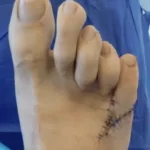
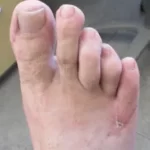

What Are Hammer Toes?
Hammer toes occur when there is an abnormal bend in the middle joint of one or more toes, often causing the toes to curl downward. This can lead to discomfort, corns, calluses, and pain while walking.
Most commonly affecting the second, third, or fourth toe, hammer toes can develop over time due to a variety of factors including genetics, ill-fitting footwear, or muscle imbalances in the foot.
Symptoms of Hammer Toes
Some of the most common symptoms include:
- Pain and discomfort in the affected toe/s
- Visible bending or curling of the toe
- Calluses or corns on the top or tip of the toe
- Swelling around the affected area
- Difficulty finding comfortable shoes
- Inflammation and redness
- Arthritis
Causes of Hammer Toes
Hammer toes are usually caused by muscle and tendon imbalances, resulting in the toe being pulled into an abnormal position. Some of the leading causes include:
- Ill-fitting shoes: Tight shoes that crowd the toes can contribute to the development of hammer toes.
- Foot deformities: Conditions such as bunions, flat feet, or high arches can increase the risk of hammer toes.
- Arthritis: Joint inflammation can affect the mobility of the toes, leading to deformities like hammer toes.
- Genetics: A family history of hammer toes can increase the likelihood of developing the condition.
- Trauma: Injuries to the foot or toes may contribute to abnormal toe positioning.
Book Your Appointment Today
If you’re experiencing pain or discomfort due to hammer toes, don’t wait! Early intervention can help relieve your symptoms and prevent the condition from worsening. Contact Foot Focus Podiatry today to book a consultation with one of our expert podiatrists in Perth.
Take the first step towards pain-free feet – we’re here to help!

